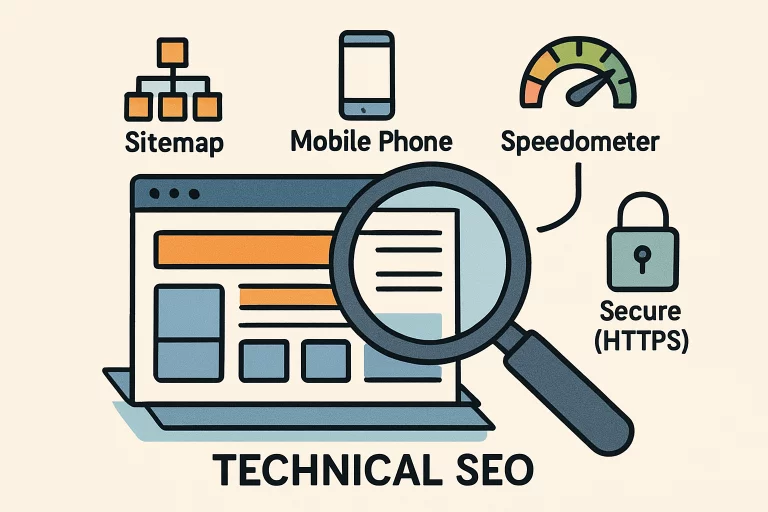Key Takeaways
- Understanding and optimizing technical SEO is crucial for enhancing website performance and improving search engine rankings.
- Implementing best practices in site architecture, mobile optimization, and security enhances user experience and search visibility.
- Staying up-to-date with emerging trends, such as AI integration and voice search optimization, is essential for future-proofing your website.
Today’s digital landscape is more competitive than ever, and delivering quality content alone isn’t enough to attract attention or drive meaningful results. The success of your website heavily relies on its technical foundation, which serves as the bedrock for both effective search engine optimization and a positive user experience. Whether you are a business owner seeking growth or an SEO professional refining best practices, understanding and applying technical SEO services is critical for achieving lasting visibility, higher search rankings, and optimal engagement. Investing in your site’s technical health not only boosts search engine friendliness but also ensures a seamless experience for visitors, giving you a definitive edge in today’s fast-evolving digital ecosystem.
Technical SEO encompasses a wide array of optimizations—from organizing your site’s architecture to adopting forward-thinking tech like artificial intelligence and adjusting to the unique nuances of voice search. At its core, technical SEO is the engine that drives your digital marketing initiatives, helping search engines efficiently crawl, understand, and rank your content. This comprehensive guide explores both established best practices and cutting-edge trends, empowering you to enhance your website’s structure, stay compliant with modern standards, and anticipate what’s next in the ever-changing SEO landscape. Armed with the proper knowledge, you can ensure your website isn’t just keeping up, but firmly ahead of the curve.
Site Architecture and Navigation
A strong site architecture is foundational to both usability and search engine effectiveness. Well-organized sites with logical hierarchies are easier for users to navigate, which increases engagement and decreases bounce rates. But just as critically, search engines rely on clear architecture for efficient crawling and indexing, ensuring your most important pages are always found and prioritized. By categorizing content intuitively and maintaining a well-defined hierarchy, you make it easier for both users and bots to access your content. Internal linking is a core pillar of technical SEO strategy; using descriptive anchor texts connects related topics, helping distribute authority and making it less likely key pages will become ‘orphaned.’ Employing regular site audits can reveal navigation gaps or dead ends that may otherwise go unnoticed, bolstering both SEO and user satisfaction. For a deep dive on this topic, check out this technical SEO guide.
Best Practices for Site Hierarch
- Keep your navigation simple and consistent across your site, which facilitates exploration and fosters trust with users.
- Utilize breadcrumbs not only as a navigation tool but also to provide additional context that helps users and search engines understand the structure of your site.
- Regularly audit your site for orphaned pages—pages with no internal links, which can be difficult for visitors or bots to locate and index, thereby hindering their SEO potential.
Mobile Optimization
Mobile devices have become the primary gateway to the web, and delivering a polished mobile experience is now a baseline expectation. Google’s mobile-first indexing means that the mobile version of your content is what gets ranked, making discrepancies between desktop and mobile versions risky. Responsive design ensures your site can seamlessly adjust layouts, images, and interactions to suit all screen sizes and device capabilities. Effective mobile optimization encompasses not only design but also focuses on usability: clickable elements should be spaced for easy tapping, forms should be straightforward, and navigation menus should not overwhelm small screens. Testing on a range of devices—rather than relying solely on emulators—can uncover specific usability or speed challenges. Moreover, as users trend towards on-the-go browsing, lightning-fast load times and an intuitive user experience help prevent drop-offs and maximize retention on mobile platforms.
Mobile Optimization Essentials
- Ensure full content parity; all features, plugins, and information should be accessible on mobile devices as they are on desktops.
- Compress images and minify resources (like CSS and JavaScript) specifically to boost loading times on mobile connections, which are often less reliable or slower.
- Utilize diagnostic tools like Google’s Mobile-Friendly Test and Lighthouse to identify and resolve usability issues before they affect your visitors

HTTPS and Site Security
Security is a non-negotiable aspect of modern web development and technical SEO. HTTPS isn’t just about protecting sensitive data—it’s about building trust with users and with search engines. Google rewards secure sites with ranking boosts and prominently marks insecure (HTTP) sites, which can deter users. To secure your site, implement SSL certificates, enforce HTTPS on every page, and actively maintain site security via routine updates and security headers. Audit embedded third-party scripts and plugins frequently, as these can introduce new vulnerabilities. Addressing malware and intrusions swiftly also limits the possibility of getting penalized or blacklisted by search engines. The confidence you instill through robust site security leads to greater visitor trust, improved user retention, and enhanced organic ranking potential.
Site Security Checklist
- Enforce HTTPS by redirecting all HTTP traffic to the secure version, ensuring data privacy for your users.
- Stay current with security updates for all platforms, plugins, and scripts in use, which helps close common loopholes exploited by attackers.
- Utilize website monitoring to detect malware, unauthorized logins, or suspicious behavior, allowing you to respond quickly to potential threats.
Structured Data and Schema Markup
Structured data—most notably implemented via schema markup—empowers search engines to interpret and present your content in more meaningful ways. By adding context to elements like articles, reviews, events, or products, schema helps your pages become eligible for rich results, which often feature images, star ratings, or quick answers that can significantly increase your click-through rates. A detailed schema implementation ensures your pages stand out in crowded search results, supporting higher engagement and potentially achieving voice search success. Regularly validate your schema with tools such as Google’s Rich Results Test to ensure accuracy and avoid technical errors, which maximizes your website’s SEO benefits by making every page work harder in the SERPs. For more tailored technical SEO advice, refer to reputable resources, such as Ahrefs’ technical SEO guide.
AI and Machine Learning in SEO
The integration of AI and machine learning is reshaping how SEO strategies are developed, executed, and refined. AI tools can process vast datasets, revealing ranking factors and search insights that might escape traditional manual analysis. This enables SEOs to identify lucrative long-tail keywords, pinpoint new content gaps, and comprehend user intent at a granular level. Machine learning further powers personalized content recommendations and can dynamically optimize internal linking or content layouts for higher engagement. Predictive analytics even enables forward-looking SEO planning, allowing you to adjust strategies in response to anticipated shifts in search behavior. Adopting AI-powered SEO solutions means your efforts are not only efficient but also resilient against changing algorithms, keeping your optimization tactics aligned with emerging user and search engine trends.
Voice Search Optimization
Voice search is experiencing explosive growth, driven by the increasing adoption of smart speakers and virtual assistants that are integrated into daily life. Users interact with voice search differently—they pose natural, conversational queries and expect concise, direct answers. Optimizing for voice involves structuring content around frequently asked questions, adopting more colloquial language, and providing clear, snippet-friendly summaries in your copy. Creating dedicated FAQ sections on key pages can boost your presence in voice search results while also enhancing your SERP real estate. Voice search optimization is ultimately about blending classic SEO with a focus on user intent and emerging search behaviors, ensuring your content is discoverable in more contexts than ever before.
Future of Technical SEO
Technical SEO is in a state of constant evolution, shaped by search engine updates, technological advances, and changing user expectations. AI, machine learning, and enhanced metrics, such as Core Web Vitals, are poised to remain central to how sites are discovered, ranked, and interacted with. According to Search Engine Land, optimizing for Core Web Vitals is now a crucial component of technical SEO, directly influencing how Google assesses page performance and user experience. To succeed in this environment, proactive engagement is essential—this includes conducting regular technical audits, investing in continuous learning, and experimenting with emerging tools and platforms. Staying informed through industry resources and search trend analysis positions you to pivot quickly, ensuring your site remains resilient and competitive, regardless of how the SEO landscape shifts. Building a robust technical SEO strategy now ultimately means future-proofing your online presence against whatever innovations tomorrow brings.











